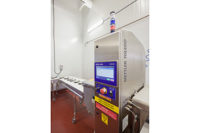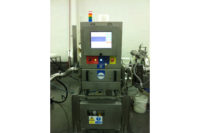How third-party x-ray inspections help prevent costly frozen food recalls
Most frozen food products are, by nature, more vulnerable to foreign contamination because they contain multiple ingredients from multiple suppliers.

One of the biggest threats to any frozen food company is a recall. Whether it’s caused by biological contamination or the discovery of foreign materials, being forced to recall a product can produce significant and often lasting effect on companies.
The price tag of a recall involves the costs of notifying any pertinent regulatory bodies, the supply chain and consumers, as well as retrieving and destroying product that has already been shipped (reverse logistics) and destroying any related product that remains at the plant. Also included is the cost of labor to not only perform all the above tasks, but also the labor costs required to produce a replacement run of the product.
Essentially, the food manufacturer will double their costs for producing the same amount of salable product, as they’ll have to pay all the associated costs for a second run, from warehouse and production line to packaging materials and shipping.
The loss beyond hard costs
If that were where the costs ended, it would still be an enormous pill for frozen food manufacturers to swallow, particularly for small companies. But, the bill can quickly run much higher.
In many cases, the direct hard costs of a food recall are usually the least expensive aspect of it, according to a study produced by the Grocery Manufacturers Association, Washington, D.C., and the Food Marketing Institute, Arlington, Va.
Some of the additional costs, which are harder to calculate and perhaps even harder to absorb, include:
- Cost of investigation. Discovering the root cause of the contamination is the way to ensure the problem doesn’t happen again. And, as part of the recall, you also have to provide basic information about the contaminant, including its size, sharpness, density and more. Documenting how and when it was discovered, how much product was contaminated and how much was shipped out is also part of the recall process, as well as providing an assessment of the health risk posed by the contamination.
- Litigation expenses. If the contaminated product causes injury or death, it can quickly lead to expensive lawsuits.
- Lost sales. In addition to the sales lost by consumers who temporarily switch brands during and after a recall, there are the lost sales created by the product simply not being available. More than half of consumers say they would switch from the product until the threat is removed, according to a study produced by The Harris Poll, Rochester, N.Y., but even if consumers return to buying the product, there’s no way to recover those lost sales.
- Media coverage. In today’s world of 24/7 news coverage, it’s impossible to avoid the negative publicity that accompanies a widespread recall. Negative coverage can keep the news story alive and in the forefront of consumers’ minds, even after the problem has been resolved.
- Social media/consumer response. Consumer response to a recall can be expensive and long lasting. Even after the threat has been eliminated, it can loom large in the buyers’ decision-making process. In 2010, a U.S. Grocery Supplier survey found that, in the year following recalls of spinach and peanut butter, about 75% of consumers quit buying those products, regardless of the brand or manufacturer.
Likewise, according to a poll by Harris Interactive, 16% of consumers said they would not purchase the product from a company following a recall and 17% would avoid any product made by the manufacturer of the recalled product.
How to eliminate frozen food recalls
With today’s improved food safety options, it would seem that contamination from foreign materials could be halted before product reaches the store shelves. However, headlines tell us that frozen food recalls continue to be a fact of life.
Most frozen food products are, by nature, more vulnerable to foreign contamination because they contain multiple ingredients from multiple suppliers. The more ingredients, the more opportunity there is for a contaminant to make its way into the food.
One of the surest ways to avoid contaminants making their way to the shelves is through the use of third-party inspection services. X-ray inspection provides an effective way to find foreign contaminants, giving frozen food manufacturers options and solutions that can prevent the contaminated product from ever reaching the shelves, while at the same time allowing safe product from the same manufacturing run to be distributed.
No frozen food manufacturer ever wants to endure a recall or a costly lawsuit. With today’s available technology, no frozen food manufacturer should have to face one either. Implementing third-party x-ray inspections gives manufacturers peace of mind that they are delivering a safe, contaminant-free product.
Looking for a reprint of this article?
From high-res PDFs to custom plaques, order your copy today!





